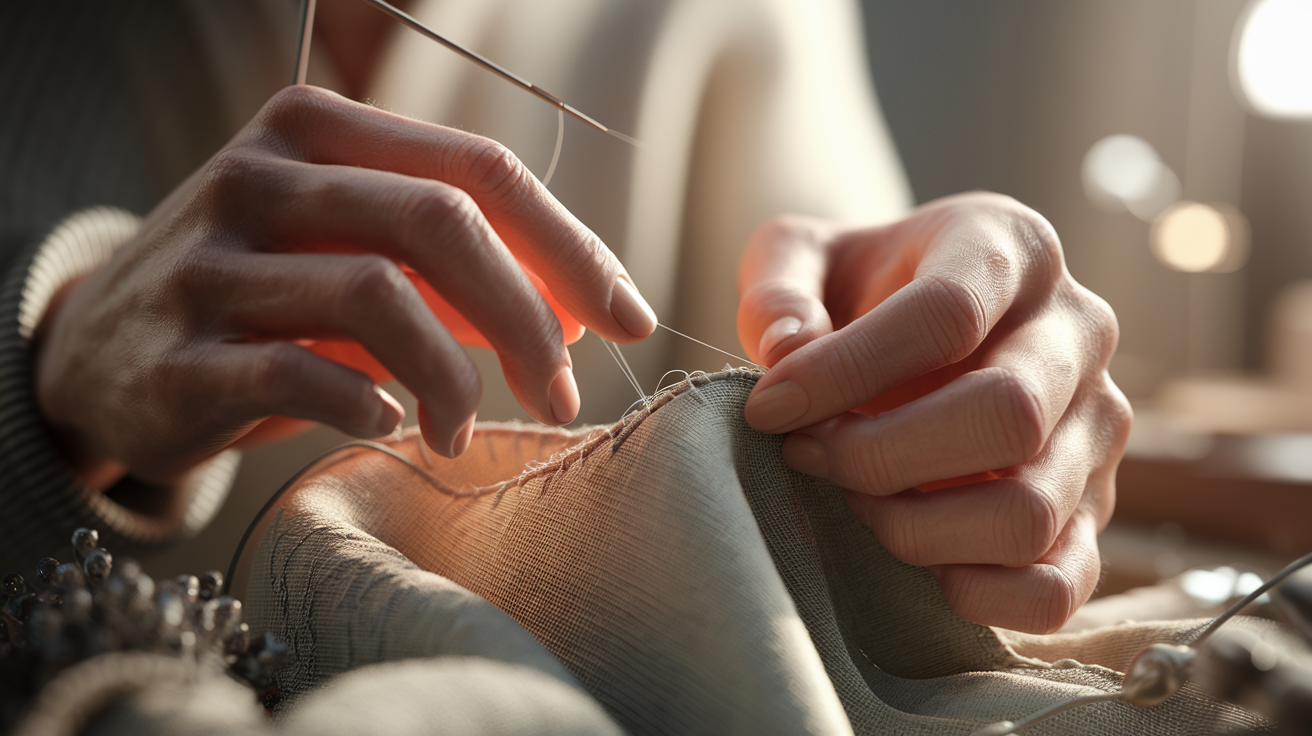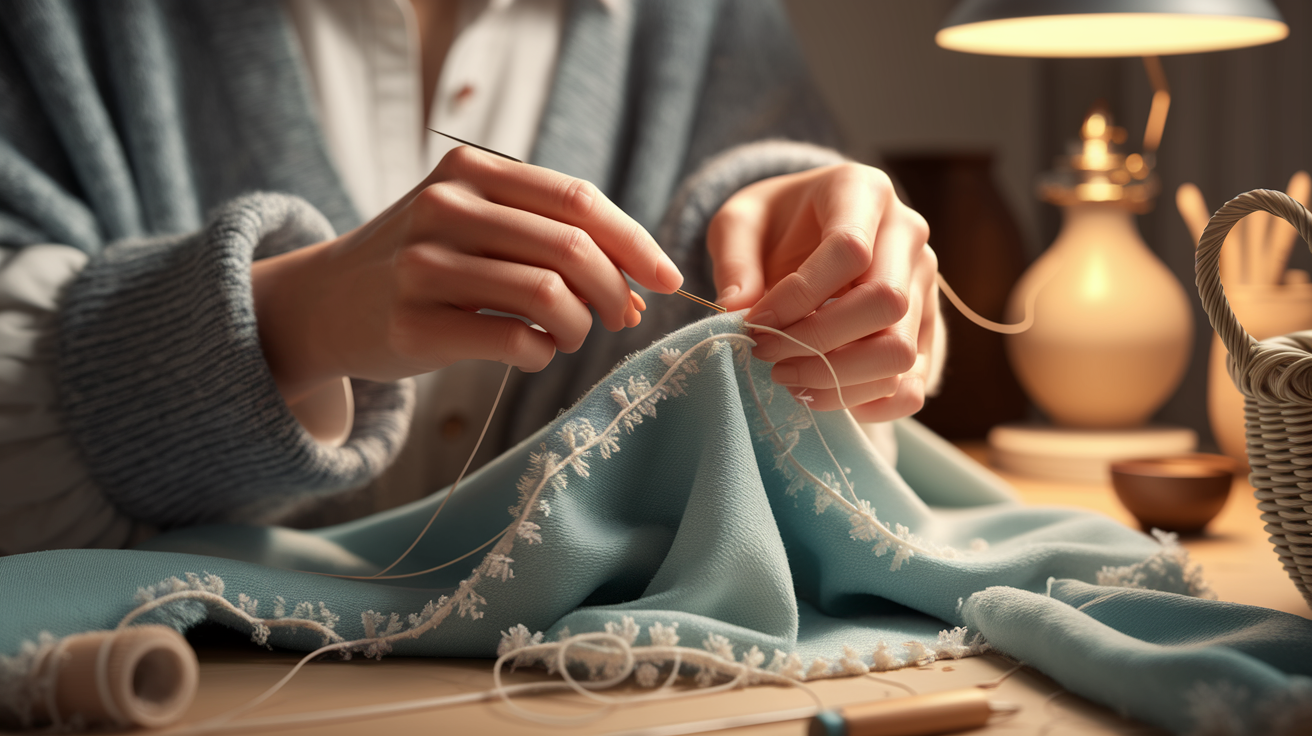Slow Stitching Techniques From The Quilters Handbook Unveiled

Modern quilters are rediscovering the profound joy of slow-stitching, finding inspiration within K. L.
Cox’s Quilter’s Handbook.
This guide beautifully merges heritage crafts with mindful crafting, elevating hand-quilting techniques into both a meditative process and a vibrant creative renaissance.
Utilizing accessible materials like fabric scraps or inherited supplies, the handbook requires no specialized tools, inviting everyone into a world of intentional creativity. Through deliberate craftsmanship, quilters of all levels can achieve creative wellbeing and uncover significant emotional benefits.
This book fosters a deeper connection to traditional craftsmanship, encouraging a focus on the artistic journey over mere perfection, ushering in an era of calm creation with every deliberate stitch.
Embrace Tranquil Artistry
Mindful crafting is an invitation to transform your sewing experience into a sanctuary of calm creation. The repetitive needlework within needlework art allows makers to achieve creative mindfulness and enter a serene flow state.
Handstitching with intention cultivates a peaceful mindset, gently guiding you to let go of the pursuit of perfection.
Instead, immense value in making is discovered, shifting focus from the final product to the intrinsic satisfaction of the act itself.
Let tranquil artistry and your personal artistic journey guide your hands.
“Analog creation feels like a grounding force in our digital age, offering a necessary respite. ”
– K. L. Cox
To enhance your artistic expression, consider setting aside a cozy, well-lit corner for your quilt projects.
This uncluttered space fosters lasting satisfaction and supports your journey toward thoughtful practices and personal tranquility. For beginner quilters and experienced makers alike, this approach offers a distinct path to creative mindfulness.
Embracing the process over product philosophy ensures that each stitch contributes to a deeply meaningful creation.
Slow craft movement principles encourage a slower approach to making, fostering deeper connection with materials and techniques.
This is a journey of intentional artistry, a rejection of fast-trend modes.
With resourceful crafting, you can transform reclaimed textiles into beautiful handcrafted quilts. Your makers journey is unique, and celebrated mistakes become part of your textile arts narrative.
Find your tranquility seeker within, and enjoy the lasting satisfaction of calm creation.

What is Slow Stitching
Rooted in the principles of creative mindfulness, slow stitching transforms the simple act of needlework into a meditative process that nurtures both patience and focused attention. Far removed from commercial, machine-based practices, slow-stitching emphasizes intentional artistry—each hand quilting stitch is placed slowly, inviting makers to savor the tactile rhythm and find tranquility within the process itself.
For beginners, starting with accessible materials such as fabric scraps, embroidery floss, and a basic needle offers an easy entry point and highlights the practice’s sustainable traditions.
Unlike fast-trend crafts, slow stitching encourages creative wellbeing by prioritizing the journey of making over the rush to a finished product, echoing K. L.
Cox’s philosophy of embracing creative exploration and mindful making.
Slow-stitching: a meditative practice fostering patience and focused attention.
Value in making; embracing deliberate craftsmanship. Starter materials, including fabric scraps and reclaimed textiles, are accessible.
Contrasted with faster, machine-based methods, this slower approach emphasizes intentional artistry.
Slow stitching transforms the simple act of needlework into a meditative process that nurtures both patience and focused attention.
Heritage skills meet modern makers through this tranquil artistry.
For beginner quilters and experienced makers alike, the focus remains on the meditative process. Enjoying the analog creation process offers emotional benefits and a deeper connection.
Hand quilting and needlework art are central to this practice. Textile arts and fiber arts find a meaningful creation here.
This slow craft movement encourages a rejection of fast-trend methods and machine-based avoidance, favoring deliberate stitches.
Discover Mindful Crafting
Immersing yourself in mindful crafting provides more than an artistic outlet; it invites calm creation and fosters a deeper connection to your project and self.
With steady, repetitive handstitching, practitioners experience reduced stress and heightened self-awareness, echoing the soothing emotional benefits described in The Quilter’s Handbook by K. L. Cox.
For a simple exercise, focus solely on the feel of fabric scraps and the sound of the needle passing through with each deliberate movement. This meditative approach to personalized quilts encourages prioritizing process over product, transforming every quilt project into a celebration of thoughtful practices and the mindful moment.
Such resourceful crafting aligns with traditions of heritage skills and inspires a lasting sense of creative wellbeing.
Mindful crafting reduces stress, increases self-awareness, and fosters a deeper connection.
Learn deliberate craftsmanship through repetitive needlework. Embrace intentional creativity with accessible materials like fabric scraps and inherited supplies.
Immersing yourself in mindful crafting provides more than an artistic outlet—it invites calm creation and fosters a deeper connection to your project and self.
Creative wellbeing and emotional benefits are at the heart of this practice. The artistic journey becomes a tranquil artistry.
Reject fast-trend approaches for a slower, more satisfying approach to textile arts.
K. L.
Cox‘s work champions this. Understand the value in making and the meditative process.
Seek tranquility through mindful making and analog creation.
Key Aspects of Slow Stitching and Mindful Crafting
- Slow stitching transforms needlework into a meditative process that nurtures patience and focused attention, prioritizing the journey of making over the rush to a finished product.
- Practitioners experience reduced stress and heightened self-awareness through steady, repetitive handstitching, echoing the soothing emotional benefits described in The Quilter’s Handbook by K. L. Cox.
- The practice emphasizes intentional artistry and deliberate craftsmanship, often utilizing accessible materials like fabric scraps and reclaimed textiles, aligning with sustainable traditions and heritage skills.
- Mindful crafting fosters a deeper connection to one’s project and self, encouraging a rejection of fast-trend methods in favor of tranquil artistry and analog creation for creative wellbeing.
Section>
K. L. Cox’s Handbook
K. L.
Cox emerges as a guide in the realm of hand quilting, advocating a gentle and mindful crafting approach rooted in heritage skills.
Drawing from a deep respect for traditional craftsmanship, her handbook outlines core principles that help both beginner quilters and experienced makers build a solid foundation for constructing quilts from accessible materials.
By focusing on intentional creativity and rhythmic, slow-stitching methods, Cox inspires makers to value process over product and find meaning in repetitive needlework rather than chasing perfection. When selecting fabrics, Cox recommends favoring natural fibers and embracing fabric scraps and inherited supplies for a tactile, sustainable, and uniquely personal quilt project.
Fabric scraps or reclaimed textiles offer a pathway to resourceful crafting, fostering a deeper connection with materials.
K. L.
Cox’s handbook offers structured guidance for those seeking a slower approach, emphasizing the value in making.
Hand quilting, a form of needlework art, becomes a meditative process when approached with her wisdom.
She encourages mindful making, making every deliberate stitch part of a larger artistic journey.
For best results, she suggests testing fabric for weight and texture, ensuring it feels delightful to your touch—an essential detail for truly satisfying hand quilting.
Her advice fosters creative wellbeing, making the process of creating handcrafted quilts a tranquil experience.
This approach supports sustainable practices, transforming remnants into something beautiful.
It’s a way to reconnect with heritage crafts and experience the emotional benefits of slow craft.
Cox’s work promotes intentional artistry, helping makers find calm creation.
.
Creating Personalized Quilts
Each quilt project can tell a story that feels deeply personal when design choices reflect the intended recipient’s individuality, creating truly personalized quilts. Personalized quilts gain meaning through the thoughtful selection of fabrics—perhaps featuring colors, patterns, or even small pieces of clothing that evoke cherished memories or shared experiences.
Intentional creativity guides the selection of unique textiles, making each piece a reflection of personal history.
Meaningful creation comes from incorporating elements that resonate deeply.
To add depth and creative wellbeing, elements such as embroidered initials, memorable dates, or a signature block can transform each quilt into a true piece of needlework art.
The meditative process of hand quilting makes space for both tradition and creative innovation.
Gathering inspiration may begin with mindful observation: listen to the recipient’s favorite stories, note aesthetic preferences in their space, and use these cues to guide intentional artistry.
These thoughtful practices lead to handcrafted quilts with profound emotional benefits.
The slow craft movement embraces this personal touch, valuing the journey of creation.
Deliberate craftsmanship ensures that each element contributes to the quilt’s narrative.
This method fosters a deeper connection to the craft and the recipient.
It’s a form of textile therapy, offering calm creation and artistic expression.
Cox’s approach encourages a slower approach, celebrating the maker’s journey.
She advocates for analog creation, focusing on the tactile nature of fabric.
This ensures each personalized quilt radiates lasting satisfaction and emotional significance.
- K. L. Cox advocates for a mindful crafting approach rooted in heritage skills and traditional craftsmanship.
- Her handbook emphasizes intentional creativity and slow-stitching methods, valuing process over product.
- Cox recommends using fabric scraps and inherited supplies for a tactile, sustainable, and personal quilt project.
- Hand quilting, when approached with her wisdom, becomes a meditative process and a form of needlework art.
Your Artistic Journey
Hand quilting techniques guide your artistic journey, framing crafting as a personal evolution. Embrace experimentation and learn from celebrated mistakes; this slower approach yields lasting satisfaction.
Intentional creativity transforms projects from fabric scraps and inherited supplies into opportunities.
K. L.
Cox, in her handbook, advocates process over product, fostering tranquil artistry during creative blocks. Persistence in your makers journey is fundamental; make deliberate stitches daily, embracing analog creation’s value in making.
Accessible materials mean anyone can begin their own creative renaissance.
Beginner quilters and experienced makers alike find solace in repetitive needlework. Mindful crafting promotes creative wellbeing, offering emotional benefits through each deliberate stitch.
Your artistic journey invites creative exploration, a slow craft movement for the soul.
Value in making stems from this mindful making, fostering a deeper connection to textile traditions.
Meaningful Quilt Projects
Personalized quilts offer a canvas for heartfelt expression, transforming fabric scraps and reclaimed textiles into cherished heirlooms.
Meaningful quilt projects begin by gathering sentimental pieces, letting inherited supplies whisper stories through traditional craftsmanship. Handstitching unites thoughtful practices and intentional artistry, as you carefully select color palettes and incorporate personal motifs, deepening the emotional benefits.
Mindful crafting preserves heritage skills and infuses each quilt with emotional benefits, linking generations through tangible expressions of love. Every quilt becomes a reflection of your creative wellbeing and the enduring value in making.
Creating Your Memory Quilt
Hand quilting is a meditative process, a slow-stitching companion for tranquility seekers.
Needlework art captures memories, transforming reclaimed textiles and inherited supplies into personalized quilts.
Embrace the slow craft movement, finding mindful creation in every deliberate stitch.
Quilt projects become opportunities for emotional benefits, a form of textile therapy.
Intentional creativity emphasizes the value in making, fostering creative mindfulness and a slower approach to life. Your makers journey celebrated is one of deliberate craftsmanship.
Resourceful crafting with accessible materials allows for unique, handcrafted quilts.
Sustainable practices are inherent when repurposing fabric scraps and inherited supplies. The Quilter’s Handbook by K. L.
Cox provides structured guidance for this journey.
Handstitching offers a meditative process, a tranquil artistry for those seeking calm creation.
Creative mindfulness flows through each repetitive needlework, connecting you to textile traditions.
This analog creation fosters a deeper connection, a rejection of fast trends for lasting satisfaction.
| Key Concepts in Artistic Quilt Making | Benefits Highlighted |
|---|---|
| Hand Quilting Techniques | Personal evolution, lasting satisfaction |
| Intentional Creativity | Transforms scraps into opportunities, fosters tranquil artistry |
| Mindful Crafting | Promotes creative wellbeing, emotional benefits |
| Accessible Materials | Enables anyone to begin, solace in repetitive needlework |
The Art of Hand Quilting Techniques
Embarking on the journey of hand quilting, a profound needlework art, reveals a spectrum of stitch styles. These techniques shape the texture and character of your quilt projects, transforming simple fabric into something extraordinary.
For instance, the humble running stitch provides essential structural strength, securely holding layers together, while decorative styles like Sashiko or shadow stitching create intricate patterns, adding pronounced depth to your personalized quilts.
Mindful crafting, a core principle in K. L.
Cox’s philosophy, highlights how varying stitch length and density can significantly add visual interest to your work. Each technique plays a role in preserving traditional craftsmanship, fostering a deeper connection to heritage skills.
To maintain consistent tension and ensure lasting satisfaction, employing a thimble and regularly adjusting your grip for even stitches is recommended. Intentional creativity encourages distinguishing between structural stitches, which hold layers together, and decorative alternatives that bring artistry and flair to each piece.
This approach values the process over product, celebrating both deliberate craftsmanship and joyful imperfection, much like a slow-stitch companion.
Embracing this slower approach allows for a tranquil artistry, promoting creative mindfulness and a meditative process.
This is a wonderful way to start your makers journey, valuing making for its own sake. The artistic journey embraces analog creation, making it accessible to beginner quilters and experienced makers alike, including modern quilters and minimalists.
Handstitching, a form of deliberate craftsmanship, offers emotional benefits and fosters creative wellbeing. It’s about resourceful crafting, using accessible materials like fabric scraps or reclaimed textiles, perhaps even inherited supplies, embodying sustainable practices.
Machine-based avoidance can lead to a creative renaissance, a more intentional artistry, and a rejection of fast trends.
This textile therapy offers calm creation, a lasting satisfaction, and a celebrated approach to mistakes.
It’s the essence of mindful making, a path to tranquil artistry and meaningful creation through repetitive needlework. This is where you’ll find a tranquil seeker, cherishing the meditative process.
It is truly a textile tradition, a part of the slow craft movement.
Exploring Different Hand Quilting Stitch Styles
Discovering diverse hand quilting techniques allows for a beautiful exploration of texture and dimension in your textile arts.
The selection of stitches, from foundational to ornate, significantly influences the final aesthetic of your handcrafted quilts.
Intentional creativity guides the choice between stitches that focus on structural integrity and those that serve as decorative elements, enhancing the visual narrative of your quilt projects.
This mindful crafting approach emphasizes the beauty found in deliberate stitches.
Tips for Maintaining Consistent Tension
Achieving consistent tension is key to the polished appearance of your hand-stitched work, contributing to the lasting satisfaction of your projects.
Employing a thimble can aid in precise needle control, while regularly adjusting your grip ensures even stitch length, a hallmark of deliberate craftsmanship. This thoughtful practice is part of the meditative process intrinsic to hand quilting.
For beginner quilters, this structured guidance is invaluable, offering a path to tranquil artistry.
Differentiating Decorative and Structural Quilting Stitches
The distinction between decorative and structural quilting stitches enriches the creative mindfulness inherent in handwork.
Structural stitches, like the reliable running stitch or backstitch, provide the foundational strength needed for quilt projects, ensuring durability through deliberate craftsmanship. Decorative stitches, conversely, elevate the artistry, introducing visual interest and depth, transforming your work into personalized quilts and a testament to intentional creativity.
This focus on process over product celebrates the maker’s journey and the beauty of analog creation, a core tenet of the slow craft movement. It offers a pathway to creative wellbeing and emotional benefits, embracing the value in making with accessible materials and often, reclaimed textiles.
- Hand quilting is a needlework art that transforms fabric into extraordinary quilt projects through various stitch styles.
- Stitch length and density significantly add visual interest to hand-quilted work, as highlighted by K. L. Cox’s philosophy of mindful crafting.
- Structural stitches like the running stitch provide essential strength, while decorative styles such as Sashiko add intricate patterns and depth to personalized quilts.
- Employing a thimble and maintaining an even grip are recommended for consistent tension and lasting satisfaction in hand-stitched pieces.




